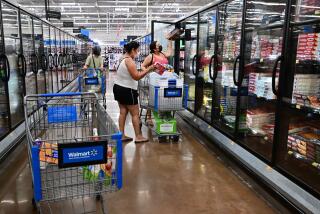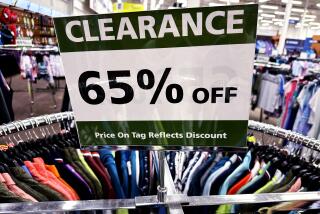Inflation slowed in July. Has it peaked?

After months of steadily climbing to a 40-year high, the pace of inflation slowed notably in July as gas prices fell sharply and Americans got relief on the cost of clothing, used cars and some other necessities.
The price index for all consumer goods and services was unchanged over the month. And the annual rate of inflation in July edged down to 8.5% from 9.1% in June, according to the Bureau of Labor Statistics in a report issued Wednesday.
The June inflation figure, the highest since November 1981, is now looking like it may have been the peak of the price surge that began in spring 2021. Stocks closed sharply higher as investors cheered the better-than-expected news, with the Dow Jones industrial average jumping 535 points and the Nasdaq composite index surging back into bull market territory.
If inflation continues a slow but steady decline — which most economists now believe is likely — it will be especially welcomed by middle-class and lower-income households that must spend much of what they earn on such staples as apparel and fuel. Food inflation, however, did not let up in July, with prices for bread and eggs up sharply.
A slowdown in inflation could not be more welcome to the Biden administration and other Democrats haunted by fears that voter fury over continual surges in the cost of living would translate into disaster at the polls.
Those political fears were all the greater because inflation not only was negating recent wage gains but had ambushed Americans lulled by decades of near-stagnant prices for most goods and services.
That period of price stability was highly unusual in the long sweep of U.S. economic history, but it lasted so long that many Americans came to take it for granted.
The sudden reemergence of inflation largely eclipsed the positive news about the economy over the last year, including the rapid and robust recovery from the pandemic and a burst of wage gains after years of income stagnation for all but the most highly paid workers.
Unhappiness over inflation has been widely seen as one of the primary reasons for President Biden’s low approval ratings.
The July inflation report comes on the heels of other recent positive developments that include the retreat in gas prices, resilient job growth and a rebound in stock markets.
Democrats in recent weeks have also scored some legislative victories, including expected passage later this week of a major bill to combat climate change and control drug prices, among other things.
Whether this will make a difference in the midterm election remains to be seen, but people’s perceptions of the economy are often seen through the lens of their partisan leanings, and, according to political scientists, tend to be baked into their voting decisions by summer’s end.
No matter how one may view the U.S. economy, there’s no question that inflation is the biggest economic challenge right now for policymakers, business leaders and consumers.
And Wednesday’s report, encouraging as it was, showed that prices for some everyday essentials are still rising at an uncomfortably high rate.
The cost of shelter, including rent, rose 0.5% in July from June and was up 5.7% over the last 12 months. The price of milk held largely steady over the month but was almost 16% higher in July than a year earlier. The war in Ukraine continues to put pressure on global grain supplies and prices, and an outbreak of avian flu has hit poultry products and eggs.
“Just have to watch for bargains and pricing, which I didn’t used to do,” said Jean Williams, 66, of Tehachapi in Kern County, who recently had no trouble finding part-time work at a local grocer to supplement her Social Security income. Williams says she also shops more at dollar stores, loading up on canned foods.
“I’ll make a big pot that’ll last, like ramen noodles with veggies thrown in,” she said.
Besides fuel costs, prices last month dropped for apparel, footwear, used vehicles, airline fares and appliances.
One month’s numbers aren’t likely to change the Federal Reserve’s plan to keep hiking interest rates, especially in view of the still-hot labor market.
Moody’s Analytics, a research and forecasting firm, projects the rate of inflation will recede to 6.5% at the end of the year.
That’s a big decline statistically, but inflation is not expected to return to near the Fed’s 2% target until well into 2024. And projections are based on benign outcomes involving the path of the pandemic, the economic fallout from Russia’s invasion of Ukraine and the Fed’s calibration of monetary policy, said Mark Zandi, chief economist at Moody’s.
The Fed has raised its benchmark short-term rate four times this year, the last two by a supersized 0.75 of a percentage point each. Another similarly large rate hike could come in September.
“While the worst of it may be behind us, the central bank has years of hard work in front of it, and the goal of restoring price stability may cause a recession next year,” said Joseph Brusuelas, principal and chief economist at accounting firm RSM.
One of the Fed’s chief goals in raising rates is to cool the labor market and prevent a wage spiral from taking effect and reigniting inflation pressures.
Although the unemployment rate last month returned to the pre-pandemic, 50-year low of 3.5%, statistics suggest that average wage growth may also have peaked at around 5%.
There are indications that in tech and interest-sensitive sectors such as finance and housing, more businesses are laying off employees. And workers appear to be more reluctant to hop jobs in search of better pay and benefits.
Those same concerns are expected to prompt households to pull back on spending, reducing demand that had surged in the last year as consumers, flush with cash from government stimulus checks and booming asset prices, were eager to remake their kitchens or buy entertainment systems or in-home gym equipment.
That had helped gum up supply chains, but some of the major logistics problems have eased recently. Cargo ship backlogs in Southern California, for example, have declined for six straight months, and pressures are ebbing at other modes of transportation as well, Oxford Economics said in a research report.
At the same time, commodity prices fell 8% on average in July, Oxford Economics said, although any easing of inflation at the producer level is far from widespread or even.
Greg Danenhauer, co-owner of Parker Boiler Co., a 70-employee manufacturer in the City of Commerce, said he’s seen little relief in prices and delivery times of key materials and parts, including steel, pumps and valves.
Apart from lumber, he said, “we’re not seeing it yet, but we hope to.”
More consumer goods producers and retailers, including Walmart, already have started to cut prices or at least hold down increases in an effort to move mounting inventories.
For consumers, the most noticeable — and favorable — development on inflation over the last month is what they’re paying at the filling stations.
Nationally, a gallon of regular gas jumped to a record high of $5.02 on June 14 but has since fallen to a little over $4, according to the American Automobile Assn. In California, it’s dropped to about $5.40 a gallon from a peak of $6.44 in mid-June.
That reflects lower crude oil prices as more supply has come online, including Biden’s release of strategic reserves, and as slower global growth has curbed demand. Fears of harsh European energy sanctions against Russia have also eased, which in turn has reduced fears of fuel shortages next winter.
Prices are likely to remain volatile, but for now, most everyone is taking some comfort from the sharp decline at the pumps — perhaps especially Biden.
The president’s public approval rating for his handling of the economy remains low, but there’s one part of that category that in July got a slight bounce.
According to an ABC News/Ipsos poll last weekend, 34% of Americans said they approved of Biden’s handling of gas prices — up seven points from early June.
More to Read
Get the L.A. Times Politics newsletter
Deeply reported insights into legislation, politics and policy from Sacramento, Washington and beyond. In your inbox three times per week.
You may occasionally receive promotional content from the Los Angeles Times.







